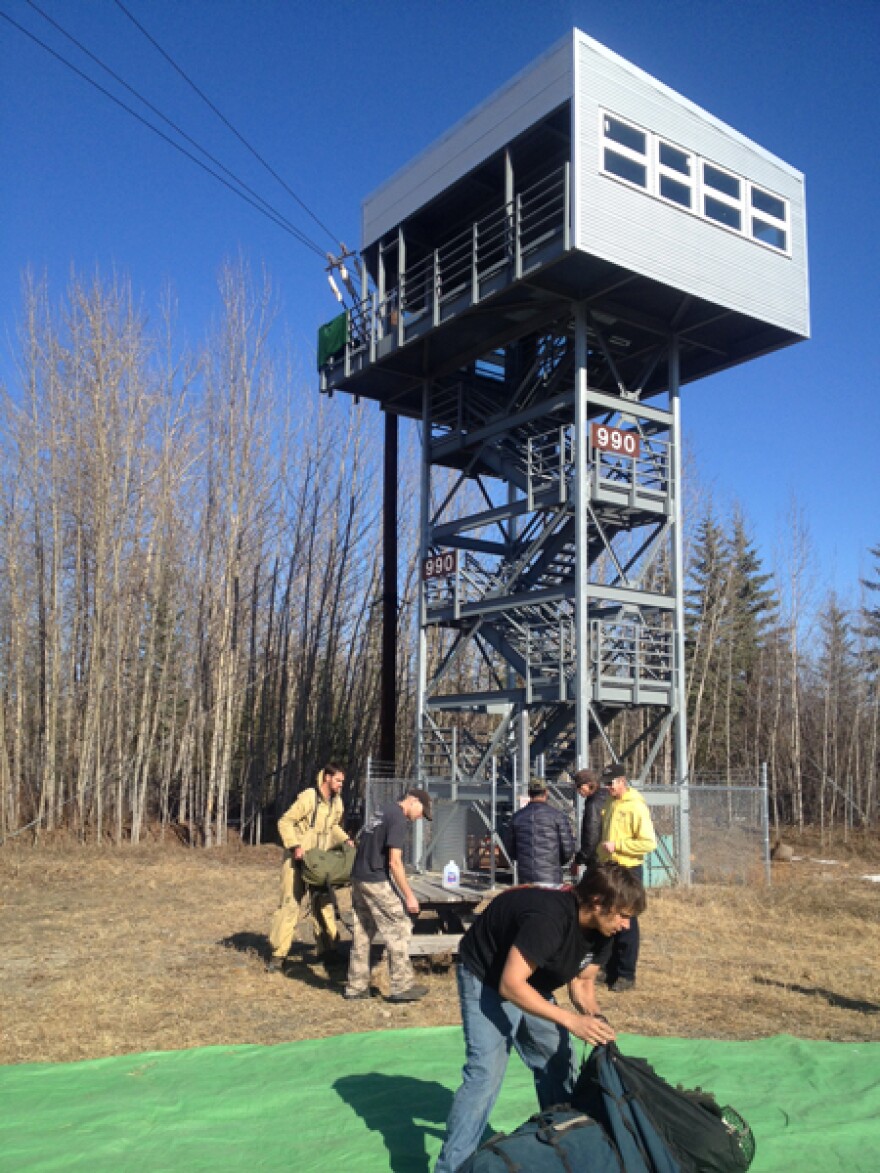The first Red Flag warnings have already been issued for parts of Southcentral and the Interior and wildland firefighters are gearing up for the season. Some of them will approach wildfires from the ground, but there’s one elite group that’s been training for more than two months to fight fire from the air. KUAC’s Emily Schwing caught up with the Alaska smokejumpers to find out how they train and why they do it. Download Audio
“First jumper get in the door,” a spotter said, as a group of the most elite wildland firefighters in the nation climb to the top of a three-story metal tower with a zipline standing at the end of a small field in Fairbanks.

The jumper is only about 50 feet off the ground, but the exercise simulates what it’s like to stand at the open door of an airplane, 3,000 feet above the ground. It’s the same kind of scenario smokejumpers will face if there’s a real wildfire. The firefighter takes off across the zip line
“Get ready,” the spotter said. “Jump-thousand, reach-thousand, wait-thousand, pull-thousand.”
Lisa Allen repeats the spotter’s words, watching from across the field. She’s spent the last 18 years fighting wild fire all over the Western US. Like most smokejumpers, she started on the ground before she took to the skies.
“It’s a very efficient way to get to a fire. I love being in the sky, I love flying,” Allen said. “I wouldn’t say I’m an adrenaline junkie but I do like the thrill of it and just the independence of it.”
Hurling oneself from a moving aircraft into a blazing inferno might seem like something that comes with a long list of potential dangers, but Allen says there are really only a handful of things that can go wrong.
“They’re very rare, they rarely ever happen, but if you don’t handle them correctly, they can have very serious consequences,” she said.
Smokejumpers train to fight wild fires that can’t be reached from the ground. These are blazes that flare up far from road systems and in some of the most remote parts of the country. What smokejumpers do is different from their land-going counterparts, who try to contain fire by approaching it from its outside edges. Training for smokejumpers is rigorous and requires more than just fire-fighting skills. Robert Jaeger is the Crew Supervisor for the Alaska Smokejumpers. He thinks the fitness test is the most nerve-wracking part.
“We have to do a PT test every year and it’s not that hard, but someone is timing you and it’s for your job,” Jaeger said. “So it’s pass or fail. If you don’t pass, you don’t have a job.”
They have to run a mile and half in under 9 minutes and 30 seconds or three miles in 22 minutes and 30 seconds. They also have to do 10 pull-ups, 60 sit-ups and 35 pushups. Jaeger has been jumping for 24 years and he hasn’t failed yet.
“It’s always close!” Jaeger said. “Even if you get it easy, it’s still hard.”
Maybe the hardest test involves packing 110 pounds for 3 miles in less than 90 minutes. Kevlar jumpsuits the smokejumpers wear, combined with all the gear they carry in the field can weigh even more than that. They train as much as they do in part because they also have to ready at a moment’s notice. Lisa Allen says when they are called to a fire, they don’t have much time grab all their gear and get on an airplane.
“You have two minutes from the time the siren goes off to the time you need to be on the plane, because they want to be rolling out of here in four minutes and then wheels up flying in six minutes,” Allen said.
But even with all the preparation, there are still stories of close calls. Operations Supervisor Rob Allen has been jumping since the early 1990s. He says it’s about knowing his gear, understanding the risk and trusting his fellow jumpers.
“We know it’s dangerous,” Allen said. “We know things could happen bad and when things go bad for us, they generally go really bad but we hope that with our training and the way we communicate with each other and pay attention to stuff, that we can get out of trouble as fast as we can get into it.”
Back on the zipline, a jumper works through a simulated parachute malfunction. Lisa Allen says the slow, methodical counting helps him keep a time frame.
“In stressful situations, you can become unaware really quickly of time passing and in that situation time is of the essence so you want to stay in a very sequenced count to get a canopy up above you that’s going to save your life,” Allen said.
The smoke jumping base in Fairbanks is one of nine run by the federal government in the nation. In all, roughly 400 smokejumpers are training to fight fires this year.



